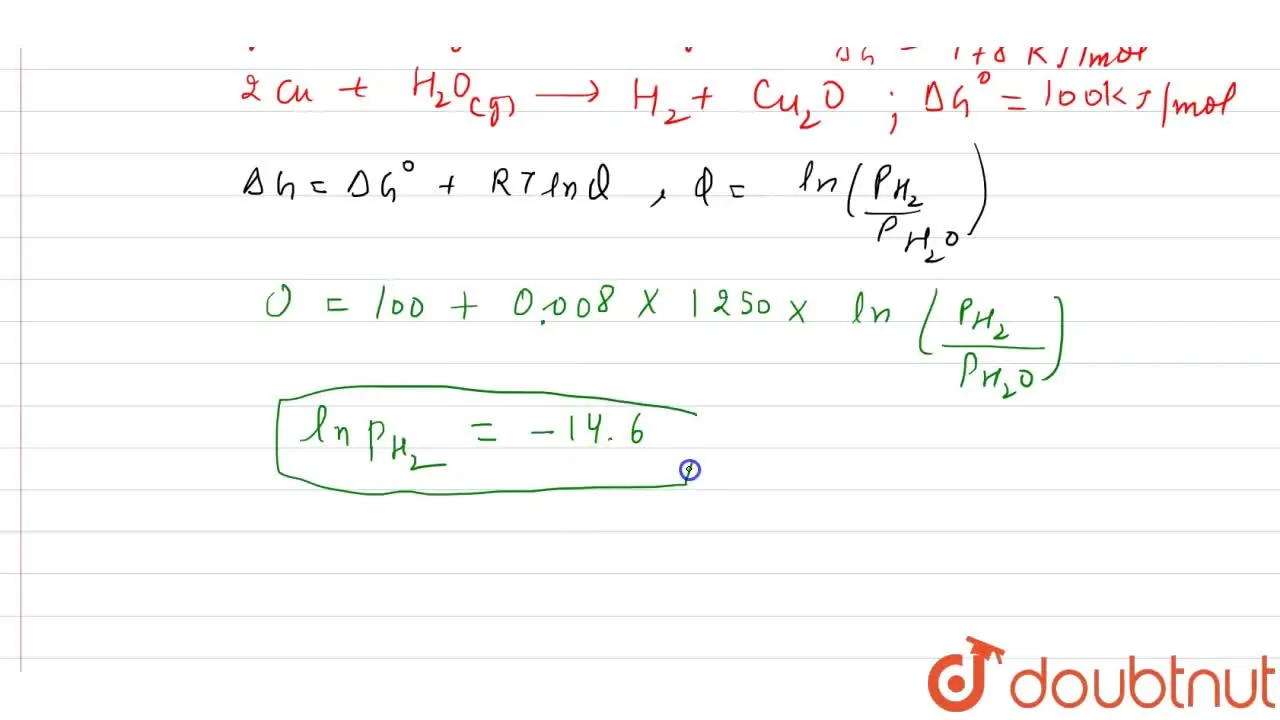The surface of copper gets tarnished by the formation of copper oxide. N2 gas was passed to prevent the oxide formation during heating of copper at 1250 K. However, the N2 gas contains 1 mole % of water vapour as impurity. The water vapour oxidises copper as per the reaction given below: 2Cu(s)+H2O(g)→Cu2O(s)+H2(g) is the minimum partial pressure of H2 (in bar) needed to prevent the oxidation at 1250 K. The value of ln is ____. (Given: total pressure = 1 bar, R (universal gas constant) = 8JK−1mol−1,ln(10)=2.3.Cu(s)andCu2O(s) are mutually immiscible. At 1250 K:2Cu(s)+1/2O2(g)→Cu2O(s)
△Hθ=−78,000Jmol−1
H2(g)+1/2O2(g)→H2O(g),△Gθ=−1,78,000Jmol−1, G is the Gibbs energy
The correct Answer is:−14,6
2Cu=12O2(g)→Cu2O(s),ΔG∘1=−78kJ ….(i)
H2(g)+12O2(g)→H2O(g),ΔG∘2=−178kJ …..(ii)
2Cu(s)+H2O(g)→Cu2O(s)+H2(g),ΔG∘3=100kJ .....(iii)
Eq.(i) Eq.(ii) = Eq.(iii)
⇒0=100+81000×1250ln(PH2)PH2O⇒−1058=1250ln(PH2)1100×1(1%of1bar)
⇒−10=lnPH2×100⇒−10=lnPH2×ln102
PH2=−10−4.6=−14.6.
Related Playlists
- BOOK - VMC MODULES ENGLISHCHAPTER - THERMOCHEMISTRYEXERCISE - JEE MAIN (ARCHIVE)20videos
THERMOCHEMISTRY
- BOOK - VMC MODULES ENGLISHCHAPTER - THEORY OF SOLUTIONSEXERCISE - JEE Advanced (Archive)31videos
THEORY OF SOLUTIONS
- BOOK - VMC MODULES ENGLISHCHAPTER - THERMODYNAMICSEXERCISE - JEE ADVANCED (ARCHIVE)44videos
THERMODYNAMICS
Similar Questions
Justify that the reaction is a redox reaction.
2Cu2O(s)+Cu2S(s)→6Cu(s)+SO2(g)View SolutionWhat is the oxidation state of :
Copper is Cu2OView SolutionCuO+H2→Cu+H2O (reference to copper)
View SolutionThe reaction:
NH2CN(s)+32O2(g)→N2(g)+CO2(g)+H2O(l)
Was carried out in a bomb caloriemeter. The heat released was 743kJmol−1. The value of ΔH300K for this reaction would beView SolutionGiven that -
2C(s)+2O2(g)→2CO2(g)ΔH=−787KJ
H2(g)+1/2O2(g)→H2O(l)Δ=−286KJ
C2H2(g)+52O2(g)→H2O(l)+2CO2ΔH=−1310KJ
Heat of formation of acetylene is :-View SolutionH2O(l)→H2O(g),ΔH=+40.7kJ
ΔH is the heat of ……………..of water.View SolutionH2O(l)→H2O(s),ΔH=−6.01kJ
ΔH is the heat of ……………….of water.View SolutionThe following reactions take place during the extraction of copper from copper ore.
(i) 2Cu2S(l)+3O2(g)→2Cu2O(l)+2SO2(g)
(ii) 2Cu2O(l)+Cu2S(l)→6Cu(l)+SO2(g)
Identify the oxidizing and reducing agents.View SolutionFrom the equation :
3Cu+8HNO3→3Cu(NO3)2+4H2O+2NO Calculate :
mass of copper needed to react with 63 g of HNO3View SolutionIdentify the substances that are oxidised and the substances that are reduced in the following reactions.
(i) 4Na(s)+O2(g)→2NaO(s)
(ii) CuO(g)+H2(g)→Cu(s)+H2O(l)View Solution


